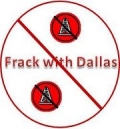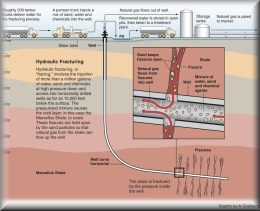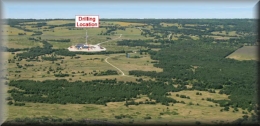 |
 |





 |








 |
    |
Hydraulic fracturing (called "frac jobs" or "frac'ing" in the industry or recently "fracking" by some news media reports) is a process that results in the creation of fractures in rocks, the goal of which is to increase the output of a well. The most important industrial use is in stimulating oil and gas wells, where hydraulic fracturing has been used for over 60 years in more than one million wells. On the other hand, high-volume horizontal slickwater hydraulic fracturing, although used for 20 years, has in the past few years seen rapid growth in its use. The fracturing (or fracing, as it is commonly referred to) is done from a wellbore drilled into reservoir rock formations to enhance oil and natural gas recovery.
 Fracking Explained Hydraulic fractures may be natural or man-made and are extended by internal fluid pressure which opens the fracture and causes it to extend through the rock. Natural hydraulic fractures include volcanic dikes, sills and fracturing by ice as in frost weathering. Man-made fluid-driven fractures are formed at depth in a borehole and extend into targeted rock formations. The fracture width is typically maintained after the injection by introducing a proppant into the injected fluid. Proppant is a material, such as grains of sand, ceramic, or other particulates, that prevent the fractures from closing when the injection is stopped. Some of the chemicals and compounds used in fracing include, but are not limited to, arsenic, mercury, lead, boron, barium, selenium, cadmium, chromium, aluminum, benzene, ethylbenzene, toluene, xylene, naphthalene, acetic acid, polycyclic aromatic hydrocarbons, methanol, formaldehyde, ethylene glycol, glycol ethers, hydrochloric acid, sodium hydroxide, manganese, 2.2-Dibromo-3-Nitrilopropionamide, Glycol Ethers, 2-butoxyethanol, Guar gum, Hemicellulase Enzyme, Acetic Anhydride, Alphatic Acid, Alphatic Alcohol Polyglycol Ether, Isopropyl Alcohol, Ammonia Persulfate, Magnesium Nitrate, Aromatic Ketones, Boric Oxide, Monoethanolamine, Butan-1-01, Crystalline Silica: Cristobalite, Polyethoxylated Alkanol (1), Crystalline Silica: Quartz, Polyethoxylated Alkanol (2), Dazomet, Polysaccharide, Diesel, Potassium Carbonate, Ethane-1,2-diol, Potassium Hydroxide, Ethoxlated Alcohol, Prop-2-yn-1-01, Ethoxylated Alcohol, Propan-2-01, Ethoxylated Octylphenol, Propargyl Alcohol, Propylene, Ethylhexanol, Sodium Bicarbonate, Ferrous Sulfate Heptahydrate, Glutaraldehyde, Sucrose, Tetramethylammonium Chloride, 2634-33-5 1,2 Benzisothiazolin-2-one / 1,2-benzisothiazolin-3-one, 95-63-6 1,2,4 trimethylbenzene, 123-91-1 1,4-Dioxane, 3452-07-1 1-eicosene, 629-73-2 1-hexadecene, 112-88-9 1-octadecene, 1120-36-1 1-tetradecene, 10222-01-2 2,2 Dibromo-3-nitrilopropionamide (a biocide), 27776-21-2 2,2'-azobis-{2-(imidazlin-2-yl)propane}-dihydrochloride, 73003-80-2 2,2-Dobromomalonamide, 15214-89-8 2-Acrylamido-2-methylpropane sulphonic acid sodium salt polymer, 46830-22-2 2-acryloyloxyethyl(benzyl)dimethylammonium chloride, 52-51-7 2-Bromo-2-nitro-1,3-propanediol, 111-76-2 2-Butoxy ethanol, 1113-55-9 2-Dibromo-3-Nitriloprionamide (2-Monobromo-3-nitriilopropionamide), 104-76-7 2-Ethyl Hexanol, 67-63-0 2-Propanol / Isopropyl Alcohol / Isopropanol / Propan-2-ol, 26062-79-3 2-Propen-1-aminium, N,N-dimethyl-N-2-propenyl-chloride, homopolymer, 9003-03-6 2-propenoic acid, homopolymer, ammonium salt, 25987-30-8 2-Propenoic acid, polymer with 2 p-propenamide, sodium salt / Copolymer of acrylamide and sodium acrylate, 71050-62-9 2-Propenoic acid, polymer with sodium phosphinate (1:1), 66019-18-9 2-propenoic acid, telomer with sodium hydrogen sulfite, 107-19-7 2-Propyn-1-ol / Propargyl alcohol, 51229-78-8 3,5,7-Triaza-1-azoniatricyclo[3.3.1.13,7]decane, 1-(3-chloro-2-propenyl)-chloride, 115-19-5 3-methyl-1-butyn-3-ol, 127087-87-0 4-Nonylphenol Polyethylene Glycol Ether, Branched / Nonylphenol ethoxylated / Oxyalkylated Phenol, 64-19-7 Acetic acid, 68442-62-6 Acetic acid, hydroxy-, reaction products with triethanolamine, 108-24-7 Acetic Anhydride, 67-64-1 Acetone, 79-06-1 Acrylamide - in fact, over 944 toxic, carcinogenic and hazardous chemicals have been identified as being used in the fracking process. Those chemicals are being pumped, under enormous pressure, into the ground where they can pollute ground water in surface and subsurface pools including lakes, rivers, creeks and aquifers. Of course, the gas industry will not tell us what they are pumping into our ground, and the 2005 Energy Act exempted the industry from having to report these under requirements of the Clean Water Act, but they tell us that these things they are doing are safe, and that they pose no threat to health or environment. Hydraulic fracturing for stimulation of oil and natural gas wells was first used in the United States in 1947. It was first used commercially in 1949, and because of its success in increasing production from oil wells was quickly adopted, and is now used worldwide in tens of thousands of oil and natural gas wells annually. The first industrial use of hydraulic fracturing was as early as 1903, according to T.L. Watson. Before that date, hydraulic fracturing was used at Mt. Airy Quarry, near Mt. Airy, North Carolina where it was (and still is) used to separate granite blocks from bedrock. Volcanic dikes and sills are examples of natural hydraulic fractures. Hydraulic fracturing incorporates results from the disciplines of fracture mechanics, fluid mechanics, solid mechanics, and porous medium flow. |
In June, 2009 two identical bills named the FRAC Act were introduced in both the United States House of Representatives and Senate. FRAC stands for Fracturing Responsibility and Awareness of Chemicals Act. The House bill was introduced by Diana Degette, Jared Polis, and Maurice Hinchey. Bob Casey and Chuck Schumer introduced the bill to the Senate. These bills are designed to amend the Safe Drinking Water Act. This would allow the Environmental Protection Agency to regulate hydraulic fracturing that occurs in states which have not taken primacy in UIC regulation. The bill also requires the energy industry to reveal what chemicals are being used in the sand-water mixture.
However, the policy calls only for the "chemical constituents (but not the proprietary chemical formulas) used in the fracturing process." Once these constituents are determined the information must be revealed to the public through the Internet. The firms that use the fracturing process have refused to disclose this information because they claim it is a trade secret. The FRAC Act states that in any case where a physician or the State finds that a medical emergency exists, and that the chemical formulas are needed to treat the ailing individual, the firm must disclose the chemical identity to the State or physician - even if that proprietary formula is a trade-secret chemical. Material Safety Data Sheets, required by OSHA under 29 CFR 1910.1200 are developed and made available to first responders and other emergency planning and response officials. ProPublica, an online journal, has published a number of reports that suggest hydraulic fracturing could be the cause of water contamination in areas surrounding drilling operations. However, the Environmental Protection Agency says that they have not been able to conclude whether fracturing is the cause of this contamination. At the same time, numerous state regulatory officials have recently confirmed that they are not aware of any confirmed instances of contamination of drinking water sources due to hydraulic fracturing in their states. The agency blames this lack of information on the 2005 Energy Policy Act because it exempts hydraulic fracturing from federal water laws. The writers of the FRAC Act claim that they are attempting to protect the people who live in close proximity to fracturing from potentially dangerous chemicals leaching into ground water resources. The energy industry does not agree with this pending policy. They see it as "an additional layer of regulation that is unneeded and cumbersome." The Independent Petroleum Association of America believes that states already sufficiently regulate hydraulic fracturing. Their research suggests that federal regulation could result in the addition of about $100,000 to each new natural gas well. Energy in Depth, a lobbying group, says the new regulation would be an "unnecessary financial burden on a single small-business industry, American oil, and natural gas producers." This group also claims that the FRAC Act could result in half of the United States oil wells and one third of the gas wells being closed. Also, the bill could cause domestic gas production to drop by 245 billion cubic feet per year along with four billion dollars in lost revenue to the federal government. The Environmental Protection Agency claims that the section that would be amended in the Safe Drinking Water Act is flexible in that it defers regulation of fracturing and drilling to the state. The EPA also says that since most states currently have regulations on fracturing, they would most likely agree with the state's policy and there would not be much change. The FRAC Act has been heard in both the House and the Senate. It has been referred to the Committee on Environment and Public Works, where it remains to this day. Congresswoman Diana DeGette says that she is still deciding if the bill is to proceed alone or if it will be attached to a larger piece of legislation. A recent indie hit movie, "Gasland", made by Josh Fox, delves into the environmental dangers of "fracking" and shares the stories of real people who have been affected by it. The movie is screening at festivals and in select nationwide cinemas, as well as on HBO. The film has won several awards, including a 2010 Sundance Film Festival award.   Hydraulic Fracturing Explained For an in-depth explanation of Barnett Shale fracturing process and geological analysis please click HERE.
Sources: |